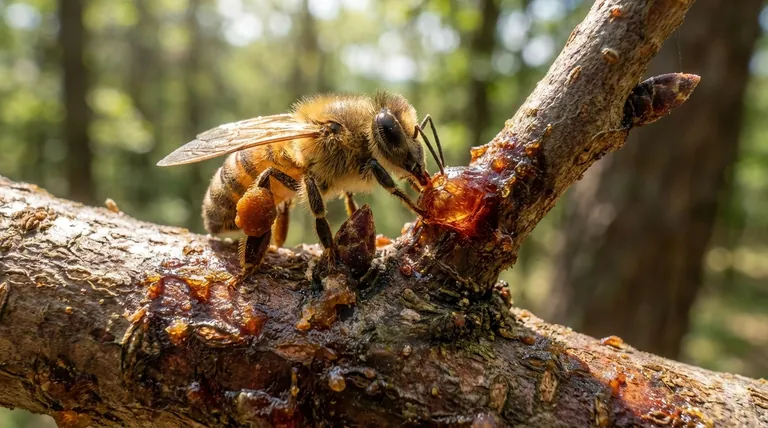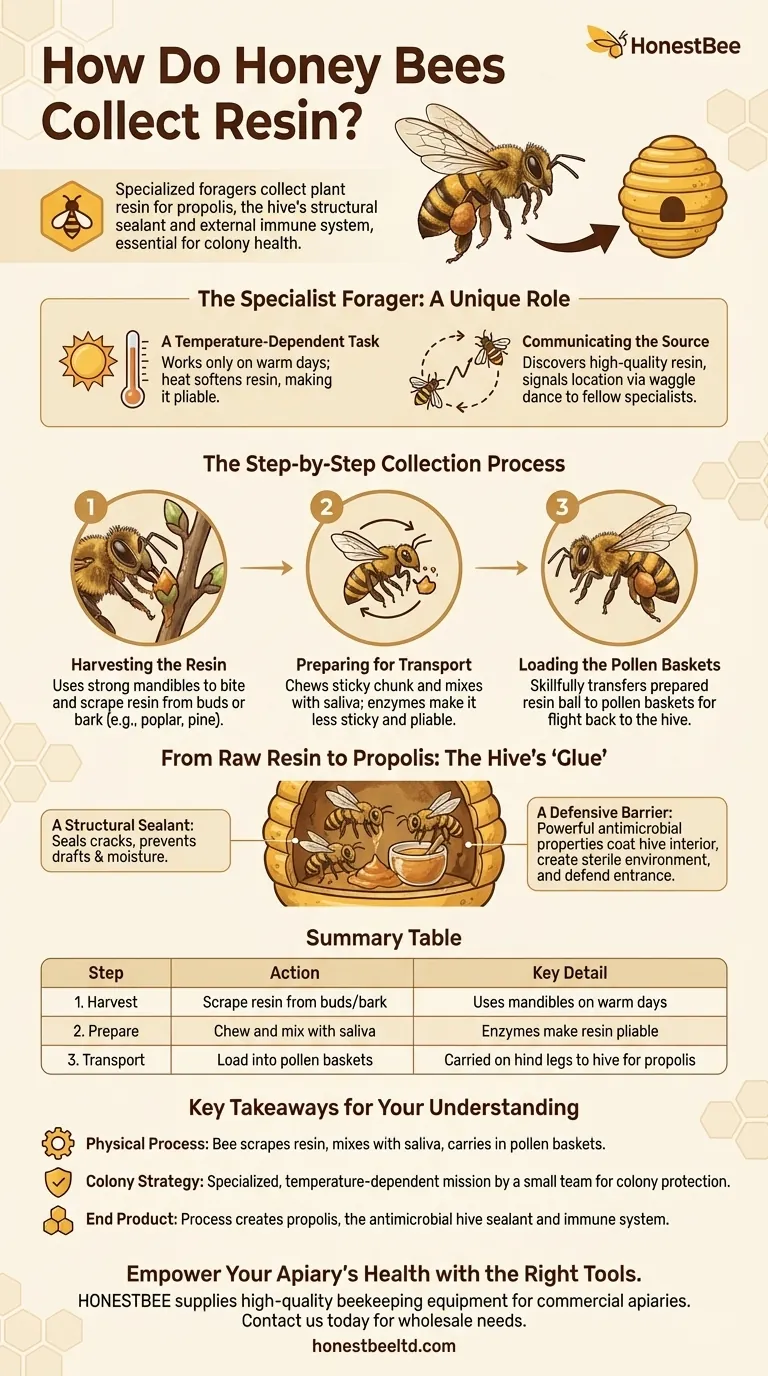To collect plant resin, a specialized honey bee forager first uses her mandibles to bite and scrape off a small piece. She then chews this sticky substance, mixing it with her own saliva to make it more pliable. Once she has a workable ball, she skillfully transfers and packs it into the pollen baskets located on her hind legs for the flight back to the hive.
The collection of resin is a deliberate and specialized task, essential for creating propolis—the hive's combination of structural sealant and external immune system. This process is not for food, but for the very health and security of the colony.

The Specialist Forager: A Unique Role in the Hive
Unlike the collection of nectar or pollen, resin foraging is a task performed by only a small percentage of a colony's workforce. These specialists possess the unique behaviors required for this challenging job.
A Temperature-Dependent Task
Resin foragers only work on warm, sunny days. The heat softens the plant resin, making it pliable enough for a bee to scrape and manipulate with her mandibles. On cool days, the resin is too hard and brittle to be collected.
Communicating the Source
When a forager discovers a rich source of high-quality resin, she communicates its location to her fellow specialists back at the hive. She does this using the same "waggle dance" used to signal the location of valuable nectar and pollen sources, underscoring the importance of resin to the colony.
The Step-by-Step Collection Process
The physical process of collecting resin is slow and meticulous, requiring both strength and dexterity.
Step 1: Harvesting the Resin
The bee uses her strong mandibles (jaws) to bite, gnaw, and scrape away at the resinous buds or bark of plants like poplar, birch, or pine trees.
Step 2: Preparing for Transport
The resin is extremely sticky. The bee works the chunk she has gathered, chewing it and mixing it with saliva. This enzymatic addition makes the material less sticky and easier to handle.
Step 3: Loading the Pollen Baskets
In a skillful maneuver, the bee uses her middle legs to transfer the prepared ball of resin to the pollen baskets (corbiculae) on her hind legs. This is the same structure used for carrying pollen, but on these trips, it is loaded with the raw material for propolis.
From Raw Resin to Propolis: The Hive's "Glue"
The collected resin is not used in its raw form. Back at the hive, other house bees take the resin from the returning forager and mix it with beeswax and enzymes to create propolis.
A Structural Sealant
Propolis, often called "bee glue," is used to seal any unwanted cracks or gaps in the hive. This prevents drafts and stops rain or other moisture from getting inside.
A Defensive Barrier
More importantly, propolis has powerful antimicrobial, antifungal, and antibacterial properties. The bees coat the entire interior of the hive with a thin layer of it, creating a sterile environment. They also use it to seal the entrance, narrowing it to defend against predators.
Understanding the Challenges
While vital, resin collection is a difficult and sometimes hazardous job for the bee.
A Sticky Situation
The process is time-consuming and labor-intensive. A bee can spend a significant amount of time gathering a single load of resin, and the stickiness can sometimes entangle her legs or wings.
A Balancing Act for the Colony
Because resin collection is a specialized task, the colony must balance the need for propolis with the more constant need for nectar and pollen. The number of resin foragers is adjusted based on the hive's structural and health requirements.
Key Takeaways for Your Understanding
- If your primary focus is the physical process: The bee scrapes resin with her mandibles, mixes it with saliva, and carries it home in the pollen baskets on her hind legs.
- If your primary focus is the colony's strategy: Resin foraging is a specialized, temperature-dependent mission carried out by a small team of bees to protect the entire colony.
- If your primary focus is the end product: This entire process exists to create propolis, the antimicrobial substance that functions as the hive's external immune system and structural sealant.
By observing this behavior, we see a clear example of the honey bee colony functioning as a single, intelligent organism that actively manages its own health.
Summary Table:
| Step | Action | Key Detail |
|---|---|---|
| 1. Harvest | Scrape resin from buds/bark | Uses mandibles on warm days when resin is soft |
| 2. Prepare | Chew and mix with saliva | Enzymes make the sticky resin pliable for transport |
| 3. Transport | Load into pollen baskets (corbiculae) | Carried on hind legs back to the hive for propolis production |
Empower Your Apiary's Health with the Right Tools
Understanding the intricate behaviors of honey bees, like propolis collection, is key to successful beekeeping. To support the health and productivity of your commercial operation, you need durable, efficient equipment.
HONESTBEE supplies high-quality beekeeping supplies and equipment to commercial apiaries and distributors through our wholesale-focused operations. From durable hive tools to essential protective gear, we provide the reliable products your business depends on.
Contact HONESTBEE today to discuss your wholesale needs and discover how our equipment can contribute to a stronger, more resilient colony.
Visual Guide

Related Products
- Professional Wide Blade Honey Scraper for Beekeeping and Honey Processing
- Professional Long-Handled Silicone Honey Scraper for Beekeeping
- 2 Frame Stainless Steel Manual Honey Spinner Extractor for Beekeeping
- Easy Use Manual Stainless Steel Honey Press for Honey Comb
- 10L Stainless Steel Electric Honey Press Machine
People Also Ask
- How can a capping scratcher be used with an electric knife? Boost Efficiency and Honey Yield
- How do you encourage bees to cap honey? Optimize Hive Conditions for a Perfect Harvest
- Why are my bees not capping honey? Understand the Key to Perfect Honey Ripening
- What equipment do you need to make honey? A Complete Guide to Starting Your Apiary
- What tools are available for uncapping honey? A Guide to Choosing the Right Tool for Your Operation



















